| |
|
|
|
|
| |
Big Trees & Totem Poles |
|
|
|
| |
|
|
|
|
| |
Aboriginal
Heritage Trees |
|
Haida Gwaii Totem Poles |
|
| |
Skeena River Totem Poles |
|
The Vanishing of Totem Trees |
|
| |
|
|
|
|
| |
|
|
| |
|
|
|
|
| |
Haida Gwaii Totem Poles
The magnificent totem poles in the Haida village of SGANG GWAAY were photographed c. 1890 (right) on Haida Gwaii, an island archipelago off the Northwest Coast of British Columbia (BC). "Haida culture is our relationship to the land in its totality. . . everything depends on everything else. The old forests of Haida Gwaii have sustained and continue to sustain our way of life. In the past fifty years, industrial logging has transformed the landscape of Haida Gwaii from diverse old forest to young, even aged stands of one or two species. The major river systems that once provided Haida villages with salmon; large cedars for longhouses and monumental art; and, plants for food, medicines, fiber and animal habitat have been eradicated by logging without consideration for these values" Haida Nation. |
|

SGANG GWAAY, Haida Gwaii, c. 1890.
Photo: BC Archives |
|
| |
|
|
|
|
| |
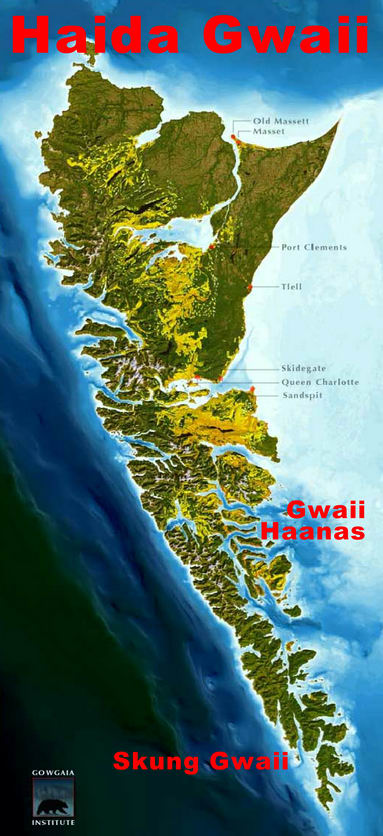
Haida Gwaii (logged forests in yellow).
Map: Gowgaia Institute
The largest collection of totem poles that survive in their original environment is on Haida Gwaii, an island archipelago located off the Northwest Coast of Canada earlier known as by its colonial name "Queen Charlotte Islands."
"The original name of Haida Gwaii is xaaydlaa gwaayaay which means 'Islands Out of Concealment of the Supernatural Beings.' This is a very special place where we lived totally in relationship with the supernatural beings. Our existence came about because of the supernatural beings bringing Haida people to live on this land and care for it for the future . . . this is the model that we have created together. A model that we can hold to the rest of the world and say this is a way for us to live together on the land, that it is sustainable for the whole world, not just for Haida Gwaii" Haida lawyer and forest activist Terri Lynn Williams Davidson |
|
"Haida culture is our relationship to the land in its totality – Ginn7waadluwaan gud7ahl Kwaagiidang – everything depends on everything else. The old forests of Haida Gwaii have sustained and continue to sustain our way of life. In the past fifty years, industrial logging has transformed the landscape of Haida Gwaii from diverse old forest to young, even – aged stands of one or two species. The major river systemsnthat once provided Haida villages with salmon; large cedars for longhouses and monumental art; and, plants for food, medicines, fiber and animal habitat have been eradicated by logging without consideration for these values" Haida Nation.
|
Xaaydaa Hlk'iiyan K'aaws
Kyaang.aay Laa
(People who look after the Forest) |
"The Haida Nation is the rightful heir to Haida Gwaii. Our culture is born of respect; and intimacy with the land and sea and the air around us. Like the forests, the roots of our people are intertwined such that the greatest troubles cannot overcome us. We owe our existence to Haida Gwaii. The living generation accepts the responsibility to ensure that our heritage is passed on to following generations. On these islands our ancestors lived and died and here too, we will make our homes until called away to join them in the great beyond." Haida Constitution
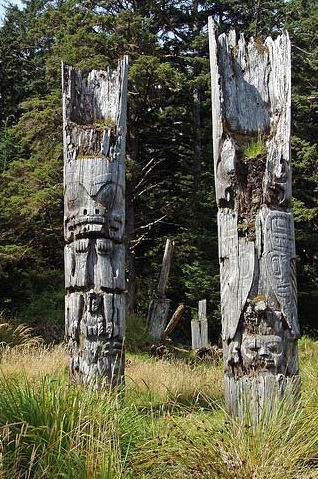
SGANG GWAAY, 2007.
Photo: Thomas Gotchy |
|
| |
|
|
|
|
| |
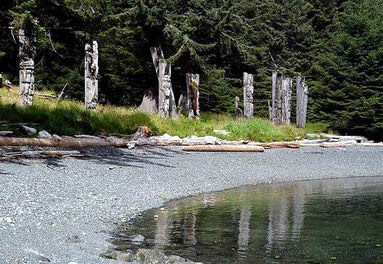
SGANG GWAAY, 2007.
Photo: Flickr |
|
The world's only complete ruins of a traditional Northwest Coast village site is located on SGANG GWAAY, which means "Wailing Island" (left). The name comes from the sound of waves surging through a hollow in a reef like a woman wailing. SGANG GWAAY is part of the Gwaii Haanas National Park Reserve. "Together, the Government of Canada and the Council of the Haida Nation manage the special place called Gwaii Haanas through a unique agreement signed in 1993. The two parties bly agree on the need to protect Gwaii Haanas, even though the question of ownership is unresolved" Haida Heritage Site. In 2005 Gwaii Haanas National Park Reserve was voted the best managed protected wilderness park in North America: National Geographic (27 June 2005). |
|
| |
|
|
|
|
| |
Gwaii Haanas exists thanks to the Haida people who stopped the industrial clearcutting of the southern part of Haida Gwaii in November 1985. Protesters formed a human blockade across a logging road and prevented the trucks from passing. As a result, 72 Haidas, including many elders, were arrested in a media event that brought Haida Gwaii to world attention and led to the creation of Gwaii Haanas.
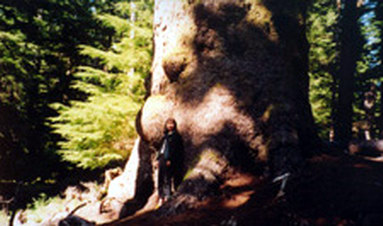
"T.C. with Lyell Island Spruce Tree."
Photo: Robert C. Davidson |
|
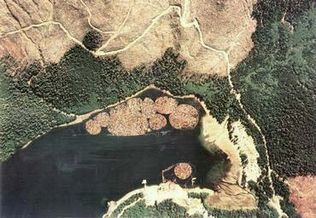
Clearcut logging, Lyell Island, 1984.
Photo: Council of the Haida Nation
"We found no honour in the people that we have to make agreements with . . . Because we haven't lost our title, and we still retain our sovereignty. And by your own laws, you weren't supposed to come on to our lands without our consent. And we haven't given that consent" Thow-Hagweth – Lavina White, Haida Elder, Voices of Indigenous Sovereignty Forum, 1994. |
|
| |
|
|
|
|
| |
"Contact with Europeans, beginning in the late 1700s had a devastating impact on the Haida population. Approximately 95 per cent of the Haida population was wiped out by disease by the 1860s. In spite of this devastation and the further effects of the reservation system and residential schools, Haida culture has not only survived, it has gained worldwide interest through the work of our artists, and through our efforts to sustain the health of our rivers, forests and ocean waters" Haida Homeland Canadian Museum of Civilization.
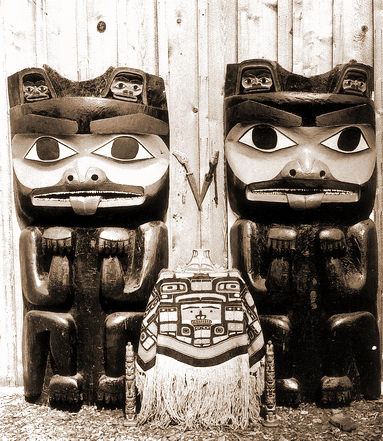
Grizzly Bear posts from Masset, 1884.
Photo: Uebersee Museum Bremen |
|
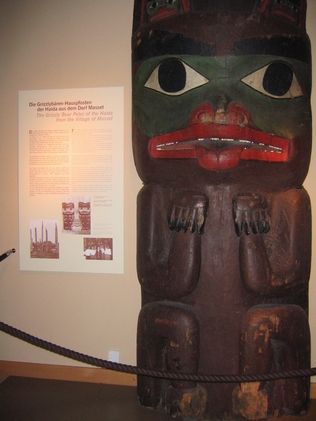
Haida Grizzly Post, Berlin, 2004.
Photo: Karen Wonders
European museums have some of the earliest collected Haida human remains as well as totem poles and other artifacts. In Berlin, the German Museum of Ethnology displays two Haida posts from the house of Chief Xa'na of Masset: "Die Grizzlybären Hauspfosten des Haidas aus der Dorf Masset." These were bought by the German collector Karl von den Steinen in 1898 from the commercial dealer Frederick Landsberg in Victoria, British Columbia. The photo to the left shows the casket of Chief Xa'na under a Chilkat blanket. |
|
| |
|
|
|
|
| |
The Pitt Rivers Museum at the University of Oxford has a
Haida pole from Masset (right). See:
Haida Totem Pole. The 11.36 metre totem pole is the largest object on display. It originally stood outside Star House (Uttewas) which had been built around 1882 and belonged to Haida Chief Anetlas (c. 1816 – 1893). Several in situ photos show the totem pole in its original village.
The Haida pole was bought for the paltry sum of $36 by E. B. Tylor, a scholar regarded as the founder of the anthropology of religion (according to his evolutionary theory, stages of religious development correspond to stages of material development). Tylor obtained the pole with the help of the Hudson's Bay Company in BC and ethnology collector C. F. Newcombe. To make its transport to England by rail and steamer easier, the totem pole was cut in two and the Raven's beak removed.
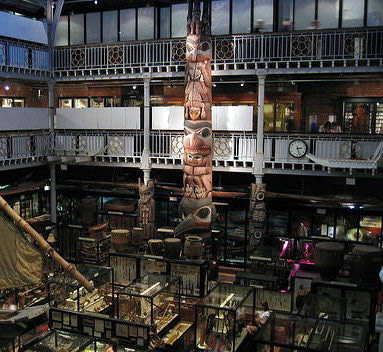
Haida pole, Pitt Rivers Museum, Oxford.
Photo: Pitt Rivers Museum |
|
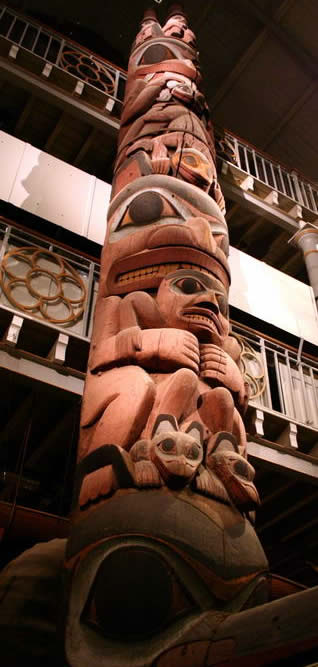
Haida pole, Pitt Rivers Museum, Oxford.
Photo: Flickr |
|
| |
|
|
|
|
| |
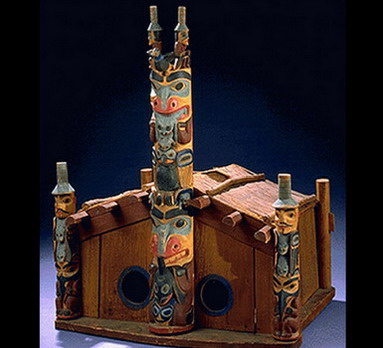
Chief Wiah's Monster House by Ch. Edenshaw.
Photo: Canadian Museum of Civilization |
|
"Following the tragic depopulation of the late 1860s due to epidemics, and deculturation in the 1870s and 1880s, the monumental sculptural tradition was abandoned. Carvers miniaturized their production into models of houses and poles, tailoring their art to the tourist market. House models were a favourite souvenir of early tourists, and Haida carvers embellished them with every conceivable decoration" Haida House Models.
The Haida house was viewed as a metaphor for a treasure box that contains wealth. It has also been compared to a living being with anatomical parts: the front door is the mouth, the back opening, created by sliding the cedar planks boards apart is the anus, the post and beams are the bones, and the roof and sideboards are the flesh of the house. A model of Chief Wiah's Monster House was created by Haida carver Charles Edenshaw (Tahayren) prior to 1914 (left). |
|
| |
|
|
|
|
| |
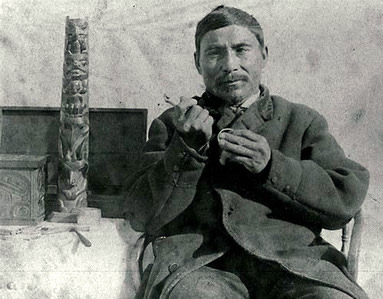
Haida carver Charles Edenshaw, c. 1880.
Photo: Canadian Museum of Civilization |
|
The Haida artist Charles Edenshaw (1839 – 1924), was one of the most talented and prolific of the Northwest Coast carvers. Edenshaw helped to preserve the ancient Haida art forms by passing his amazing carving skills on to the next generation. The frontal pole of Edenshaw's model of Chief Wiah's Monster House depicts the flood story of Qingi, and a large bearlike figure sits on top. The actual Monster House in Masset on Haida Gwaii was the largest ever built by the Haida and must have been a magnificent and unique work of architecture. Sadly, like much of Northwest Coast art older than a century, nothing survives of the Monster House today. For a Haida perspective on the carving traditions that been described as significant to the arts of humankind as those of ancient Egypt and China, see the film series "Ravens and Eagles" by Haida artist Marianne Jones which includes the fight to preserve old growth forests on Haida land. |
|
| |
|
|
|
|
| |

Totem Pole Expedition, 1957.
Photo: BC Archives
Members of the Totem Pole Expedition seen in the phot on the right are Wilson Duff, the first provincial anthropologist and an early defender of indigenous rights; Harry Hawthorn, the curator of the University of BC's Museum of Anthropology; and Bill Reid, the Haida artist. For Reid, the trip was a life changing event that reintroduced him to the powerful relationship between the environment and the monumental carving traditions of his ancestors.
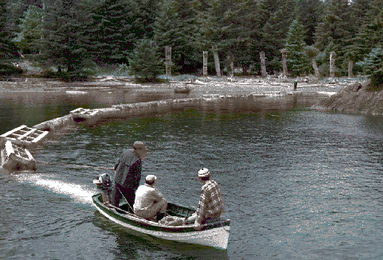
Totem Pole Expedition, 1957.
Photo: BC Archives |
|
In 1957, a totem pole expedition to SGANG GWAAY (then called Anthony Island) was organized by the BC Provincial Museum to salvage the Haida poles from the village that had been abandoned in the late 1880s and bring them back to the museum for preservation and display (left).
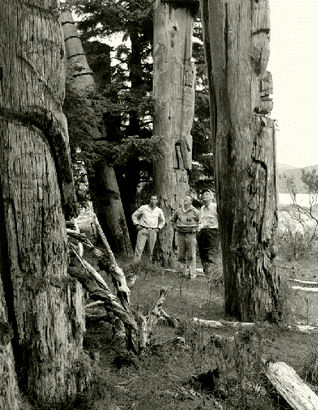
Totem Pole Expedition, 1957.
Photo: BC Archives
The Haida totem poles were removed from the ancient Haida village on the beach, crated in large wooden boxes and floated away to be taken to a larger ship for delivery to the museums in Victoria and Vancouver (left). Fortunately not all of them were removed in 1938 and 1957 by ethnologists. In 1981, the ancient village (known as Ninstints) was declared a World Heritage Site by UNESCO and today it is part of the Gwaii Haanas National Park Reserve. Tourists who wish to visit SGANG GWAAY must check with the Haida guardians. |
|
| |
|
|
|
|
| |
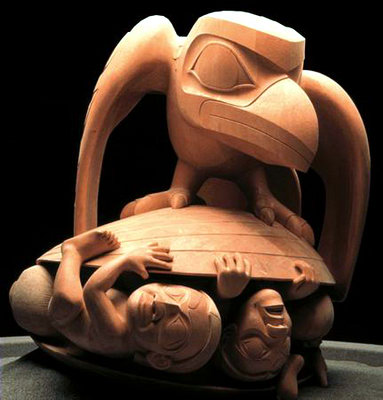
"Raven and the First Men" by Bill Reid, 1980.
Museum of Anthropology, Vancouver |
|
|
Oh, the cedar tree!
If mankind in his infancy
had prayed for the perfect substance
for all material and aesthetic needs,
an indulgent god could have provided
nothing better.
Bill Reid, 1971 |
Above: A shameful example of unethical appropriation. The famous quote by Haida carver Bill Reid is used to advertise Haida Forest Products Ltd., a non Haida company that exports ancient cedar: "Out of respect for these magnificent people and their reverence for Western Red Cedar, Haida Forest Products has adopted this time honoured name to identify the company and the premium cedar products that we manufacture Export Clears."
Haida carver Bill Reid found it impossible in 1979 to find an ancient yellow cedar tree large enough to use for his monumental sculpture "Raven and the First Men" (left). Instead he had to laminate over 100 ancient cedar beams into a 4.5 ton block. |
|
| |
|
|
|
|
| |
The sculpture "Raven and the First Men" (above) was reproduced in 2004 on the Canadian 20 dollar bill (right). Those who engage in the mass extermination of monumental cedar trees – government and industry – are hypocrites to use Haida cedar sculpture on behalf of their immoral commercialism. According to the anthropologist Claude Lévi Strauss, Bill Reid "saved from an unrepairable loss the cultural legacy of mankind." On one hand we celebrate and preserve Northwest carving traditions and on the other we sanction the industrial logging of the irreplaceable ancient cedar trees on which these traditions are dependent. |
|

$20 with images of Haida sculptures.
Photo: Bill Reid Foundation |
|
| |
|
|
|
|
| |
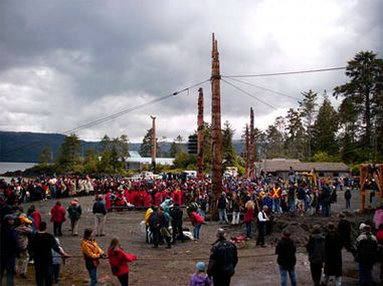
Pole raising ceremony, Haida Gwaii, 2001.
Photo: Jack Litrell |
|
In 2001 six totem poles representing ancestral villages and clans were raised at QAY'LLNAGAAY on Haida Gwaii. Each pole represents the main historic village sites of the southern Haida. Finding the material for the monumental poles was difficult as old growth cedars have become a vanishing cultural resource on Haida Gwaii.
The poles were the "Ts'aahl Pole" by Garner Moody; the "K'uuna Pole" by Jim Hart; the "Sgaang Gwaii Pole" by Tim Boyko; the "T'aanuu Pole" by Giitsxaa; the "Cumshewa Pole" by Guujaaw; and the "Skidegate Pole" by Norman Price with apprentices Matt Ridley and Jesse Jones. The photo shows the sixth pole being raised (left). On 22 January 2007, the new centre at QAY'LLNAGAAY opened. |
|
| |
|
|
 |
|
| |
|
|
| |
©
Credits & Contact |
|
| |
|
|
|
|

